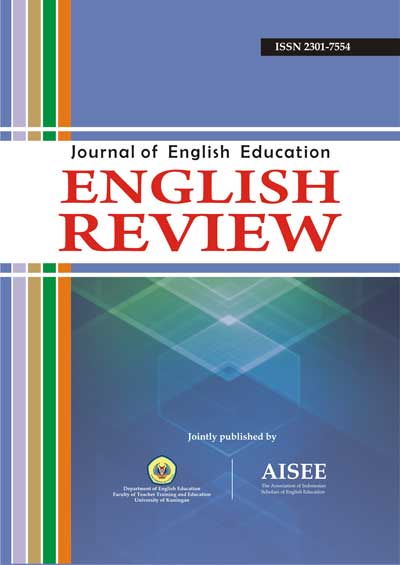INVESTIGATING THE PROBLEMS OF TEACHING AND LEARNING ENGLISH IN MIDDLE SCHOOLS IN IRAN
Abstract
Abstract: The present research aimed to investigate the problems of teaching and learning English in middle schools in Esfahan, Iran. These problems are associated with the learner, teacher, textbook, syllabus, and language policy. The instrument used was a self-constructed likert scale questionnaire. All the variables had a hand in the problems among which textbook, syllabus and language policy had the most effect. Twenty five problems were distinguished among which some are as follows: students do not consider pair work important; most of the time, most teachers do not speak in English in the classroom; the textbook does not include CDs or cassettes, does not consists of all the English Skills; the syllabus does not include one or two projects for students apart from the midterm or final test, Language Policy being not completely familiar with the steps of EFL teaching, does not selecting the most qualified and proficient teachers in EFL teaching. It can be concluded that the language policy should take a practical step in reducing the problems by changing the textbooks and providing more teaching aids for the teachers.
Keywords: teaching and learning English, problems of teaching and learning English, middle school, IranReferences
Azizifar A., Koosha M., Lotfi A. R. (2010). An analytical evaluation of Iranian high school ELT textbooks from 1970 to the present. Science Direct, Social and Behavioral Sciences, 3, 36-44.
Brown, D. (2001). Teaching by principles: An interactive approach to language pedagogy. Second edition. p.430. NY: Pearson Education.
Dahmardeh, M. (2006). Communicative Textbooks: English Language Textbooks in Iranian Secondary School. Linguistik online, 40, 4/09.
Department of Education, P.R. China. (2003). English syllabus standard. Beijing: Beijing Normal University Publishing House.
DeJong, E. J. (1994). Planning Language, Planning Inequality. TESL-EJ, Teaching English as a second or foreign language, 1(1), R-2.
George, D., & Mallery, P. (2003). SPSS for Windows step by step: A simple guide and reference. 11.0 update (Fourth Edition). Boston: Allyn & Bacon.
Huang J. (2005). A diary study of difficulties and constraints in EFL learning. Science Direct, System, 33, 609-621.
Karimnia, A. & Salehi Zade, Sh. (2007). Communication strategies: English language departments in Iran. Iranian Journal of Language Studies (IJLS), 1(4), 287-300.
Koptyug N. M. (2003).Methods of teaching, ICT in the classroom: solving EFL teacher problems. Eng.1september,ru/2003/47/1.htm. Retrieved December 7, 2011.
Nunan D. (2006). Second language teaching and learning. PP.57-58. Newbury House. Teacher Development. Tehran. Jungle Publication.
Nunan D. (2006). Syllabus design. P.5. Language teaching. Oxford university press. Tehran. Jungle Publication.
Razmjoo S. A., Riazi A. M. (2006). On the teaching methodology of Shiraz EFL institutes. Journal of social sciences & humanities of Shiraz University. 23(1), 58-70 (Special Issue in English Language and Linguistics)
Richards J. C., Rodgers Th. S. (1934). Approaches and methods in language teaching. Second edition. P. 167. Cambridge language. Teaching library. Tehran. Jungle Publication.
Romaine S. (2006). Language policy in multinational educational contexts. Elsevier Journal.
Trepanier L. (2008). What makes a good syllabus? ISI's American Studies Center. Faculty.isi.org/blog/post/view/id/32. Retrieved November 29, 2011
Wikipedia, The free encyclopedia, Leclerc, Jacques (2003). "Index par politiques linguistiques" in L'aménagement linguistique dans le monde, Québec, TLFQ, Université Laval, (in French).
All articles published in English Review: Journal of English Education (ERJEE) are licensed under the Creative Commons Attribution 4.0 International License (CC BY 4.0).
Copyright Ownership
Authors retain the copyright of their articles and grant ERJEE the right of first publication. The journal is granted a non-exclusive license to publish, reproduce, and distribute the article in any format, medium, or platform, provided that proper credit is given to the original authors.
License Terms – CC BY 4.0
Under the Creative Commons Attribution 4.0 International License, others are free to:
- Share — copy and redistribute the material in any medium or format
- Adapt — remix, transform, and build upon the material for any purpose, even commercially
As long as they:
- Provide appropriate credit to the original author(s) and source
- Provide a link to the license (https://creativecommons.org/licenses/by/4.0/)
- Indicate if any changes were made
There are no restrictions on the reuse, reproduction, or adaptation of published articles as long as attribution is properly given.
Author Warranties
By submitting a manuscript to ERJEE, authors confirm that:
- The work is original and does not infringe any existing copyright.
- The manuscript has not been previously published and is not under consideration elsewhere.
- All sources and references are appropriately acknowledged.
- Necessary permissions have been obtained for any copyrighted materials used.










